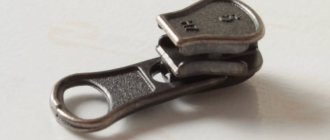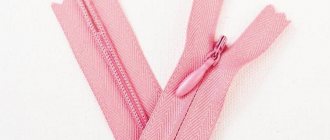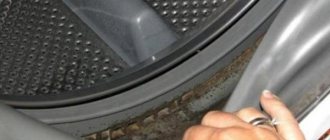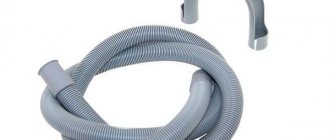The zipper is often used as a fastener on garments. Other possible names are zipper and snake. Zippers come in different lengths, from different materials (most often metal or plastic) and different colors.
Choose a zipper depending on the product. For thin fabrics - a narrow zipper with small teeth with a light braid. For heavy and thick fabrics, a zipper with thick teeth and a wide braid is better suited.
Above : Zipper with plastic teeth. Bottom : Concealed zipper. Next to each of them is a suitable paw
The zipper consists of two strips of tape connected by teeth that align with each other when you pull the keychain on the slider. The zipper can be detachable (two strips of tape can be completely separated) - these are used on coats, jackets and accessories that need to be unzipped completely. On a one-piece zipper, both strips of tape are connected at the base. The zipper can be hidden: after sewing in, only the slider keychain is visible from the outside.
There are limiters at the beginning and end of the lightning, the distance between them determines the length of the lightning.
Sewing a regular zipper
What you will need
- Needle and thread matching the fabric
- Straight stitch
- Zipper foot
The zipper is sewn in with a straight stitch using a special presser foot with a bracket for sewing in the zipper. These claws may look different for different brands, but their purpose is always the same: to make it easier to sew in a zipper, allowing you to get the needle as close as possible to the teeth.
Left : Pfaff zipper foot. Right : Janome zipper foot
The zipper foot is usually narrower than other feet and has a groove on each side. It is necessary to move the needle sideways so that it goes next to the groove.
Regardless of the brand and model, the principle of working with the presser foot is the same on both sides. Install the foot on the most convenient side: to sew in the left side of the zipper, set the foot with its right side; to sew in the right side, set the foot with its left side.
Basics of sewing a zipper
The simplest option is to sew a zipper along the entire length of the fabric, for example, along the front of a coat. For detachable and permanent zippers, the procedure will be the same.
Set the zipper foot depending on the side you will be sewing. Pre-sew the edges of the allowances to which you will sew the zipper. If the product has a lining, the sections do not need to be overcast. Fold back and press seam allowances. Pin one side of the zipper to one of the seam allowances face to face (Image 1).
Photo 1
Place the zipper teeth as close to the edge of the presser foot as possible: the presser foot should remain pressed against the teeth as you sew (Image 2). Place the needle above the line of the future stitch. Usually the stitching is done in the center of the braid. The farther the stitching is from the teeth, the more of the zipper will be visible from the outside of the product. Most often, the stitching is done from the top of the zipper to the bottom. To avoid shifting, sew both sides of the zipper in the same direction.
Photo 2. To make sewing easier, place the edge of the presser foot against the teeth of the zipper and move the needle to the side so that the stitching goes in the center of the braid
Regardless of whether the zipper is detachable or not, you will need to bypass the slider: leave the needle inside the fabric, raise the foot, move the slider under the foot so far that it does not interfere with sewing. Lower the presser foot, complete the stitching, fasten, and press the seam. Repeat the same steps for the other side of the zipper.
If desired, topstitch from the right side to reinforce the seam.
Detachable zipper
The length of such a zipper should correspond to the length of the fully unfastened part to which it will be sewn. There are detachable zippers with two sliders: the top and bottom of them can be unfastened independently of each other. The sewing procedure for it is the same as for a permanent zipper. Make sure that both parts of the zipper are aligned so that the sides are symmetrical.
Detachable zippers made of metal (black) and plastic (red)
Visible zipper sewn into detail
On some clothing items and accessories, the zipper needs to be sewn in in the middle of the piece. To sew a one-piece visible zipper into an area where there is no seam, use a facing.
Prepare the facing from a lighter fabric than the main one. It should be slightly larger than a zipper. Process the facing sections in any way (they will only be visible from the inside of the product).
On the front side of the part, mark the line along which you want to sew in the zipper (if the fabric is thin, it may be worth reinforcing it with interlining material in the direction of the grain thread). Place the facing on the product face to face and align its center with the marked line (Fig. 1). Transfer the line of the future zipper to the facing, lay a straight line around this line at a distance of 3 mm from it. Align the center of the presser foot with the marked line and move the needle to the right by 3 mm: this will allow the stitch to run 3 mm along its entire length, even after turning.
Rice. 1
Using sharp scissors, make a cut along the zipper line marked on the facing: cut the facing and the part at once, stopping 1 cm from the horizontal seam, make cuts to the corners for notching (Fig. 1).
Turn the facing inside out and iron. Place the zipper in the hole with the right side facing the facing, pin the tape on both sides to the facing and to the fabric (photo 1).
Photo 1
Place the zipper foot on the zipper foot holder. Move the needle to the side enough to catch the zipper tape, fabric, and facing. Secure the zipper with a straight stitch from the front of the garment, starting at the bottom (photo 2) and working up to the zipper.
Photo 2
Do the same with the other side of the zipper. To do this, change the side of the zipper foot (photo 3).
Photo 3
Visible zipper sewn along the seam
This technique, like the previous one, allows you to play on contrast, making the braid and zipper teeth visible. Choose a zipper that matches the fabric or a contrasting color.
Mark on both parts where the zipper will end (the point of the lower stop). Duplicate the fabric from the wrong side if it is very thin, and overcast the edges.
On each piece, mark the part of the fabric where you want the zipper to be visible. Its width should be equal to the width of the seam allowance with an increase of 6 mm for a regular permanent zipper (this value may be greater for a wider zipper), that is, 3 mm or more on each side. This part reaches the mark of the lower border of the zipper. Use a stabilizing stitch to mark the fastener area on each piece (this stitch will make it easier to fold the fabric in the next step).
Connect the two pieces with a straight stitch, placing them face to face: stitch from the bottom mark of the zipper down to the end.
Notch the corner to fold the seam allowance over the stabilizing stitch, press the seam allowance so that the stitch lines up with the fold.
Stitching a visible zipper along a seam
Having created a hole, place the zipper in it, positioning it facing the wrong side of the product. Pin the zipper to secure (or hand baste if you prefer). Sew the zipper, working from the bottom. The stitch should cover the braid and both layers of fabric.
Simple clasp for children
This technique of sewing in a visible zipper is preferable for children's clothing. The zipper teeth are not hidden, there is no risk of fabric edges getting caught in them.
Hidden zipper sewn along the seam
This technique allows you to discreetly sew in a regular zipper without using a special hidden one.
Gray contrasting threads are needed here for clarity. If you want to sew in a zipper unnoticed, take threads that match the fabric
The zipper here continues the line of the connecting seam of the product. Mark the location of the zipper: place a mark at the level of the lower limiter (Fig. 1).
Rice. 1
Run a running stitch along the length of the location where the zipper will be located, continue with a straight stitch, and make a few tacking stitches near the mark. Press the seam open.
Align the center of the zipper with the basting stitch, placing the right side of the zipper against the right side of the seam allowance. Pin the zipper tape and seam allowances together (photo 1).
Photo 1
Stitch each side of the zipper to its seam allowance, stitching down the middle of the tape from bottom to top (Photo 2).
Photo 2
Having stitched both sides, go to the front side of the product. Without opening the basting stitch, stitch around the zipper through all layers of materials. Start the stitch under the guide and work it up. Do the same on the other side.
Open the running stitch (photo 3), being careful not to damage the connecting seam under the zipper stop.
Photo 3
Zipper and stretch fabrics
Use hot-melt tape to duplicate the edges to which the zipper will be sewn: this will prevent the fabric from stretching while sewing in the fastener.
LiveInternetLiveInternet
—Categories
- 1000. +1 tip (309)
- Tips for all occasions (104)
- Little tricks of big cooking (86)
- Note to the hostess (122)
- Self-development (88)
- Memory development (48)
- Life tips (18)
- Time management (11)
- Communication Skills (9)
- Speed reading (3)
- Dancing (83)
- Latina (29)
- Zumba, dancing for weight loss (16)
- Dance elements (7)
- Club dancing (5)
- Go-Go (5)
- Oriental dance (25)
- FAQ (83)
- FAQ video (20)
- Useful (1)
- LiRu (2)
- Decoration (6)
- Memo (27)
- Our smaller brothers (667)
- Dogs (35)
- “They live like a cat and a dog” (25)
- My beast (5)
- From the life of cats -1 (156)
- From the life of cats-2 (35)
- Interesting things about cats (64)
- Kittens (19)
- Cats (pictures) (238)
- For cat owners (38)
- These nice little animals (75)
- On the World Wide Web (328)
- MuzCollection (33)
- How far has the progress come? (8)
- I want to know everything (114)
- Creative (17)
- Myths and facts (37)
- You can't make it up on purpose (3)
- Passionate faces (43)
- Amazing things are nearby! (14)
- Showbiz (40)
- Everything about everything (39)
- Life is a joy (679)
- Live easy (188)
- Rituals, fortune telling, signs (132)
- Holidays, traditions (101)
- Money Magic (73)
- Man and Woman (51)
- Simoron (36)
- Numerology, horoscope (28)
- For the soul (25)
- Feng Shui (17)
- Esoterics (4)
- Palmistry (1)
- Shrines (5)
- ABC of Faith (108)
- Health (834)
- Help yourself (382)
- Self-massage according to all the rules (82)
- Diseases (71)
- Qigong, Tai Chi Quan, Tai Chi (66)
- Acupressure, reflexology (44)
- Is old age not a joy? (27)
- Vision correction (9)
- Traditional medicine (9)
- Oriental medicine (8)
- Live healthy (136)
- Traditional medicine (50)
- Cleansing the body (43)
- Last cigarette (24)
- Israel (146)
- Cities (33)
- Promised Land (11)
- Useful information (5)
- Izravideo (21)
- Photo reports (11)
- Yoga (214)
- Yoga complexes (127)
- Yoga solves problems (43)
- Exercises (30)
- Asanas (9)
- Yoga for fingers (mudras) (7)
- Tips (2)
- Beauty without magic (1262)
- Gymnastics for the face, exercises (273)
- Luxurious hair (138)
- Massage techniques (100)
- Japanese beauty, Asian techniques (88)
- Secrets of youth (63)
- Original manicure (22)
- The path to glowing skin (122)
- Cosmetic bag (56)
- Flawless Makeup (105)
- Problems (45)
- The art of being beautiful (38)
- Style (139)
- Care (287)
- Cooking (785)
- Baking (97)
- Side dishes (18)
- First course (13)
- National cuisine (9)
- Dessert (56)
- Snacks (119)
- Dough products (84)
- Food served (51)
- Meat (118)
- In a hurry (31)
- Drinks (76)
- Vegetables and Fruits (118)
- Recipes (25)
- Fish, seafood (34)
- Salads (62)
- Sauces (8)
- Terms (16)
- Useful sites (11)
- Photos (8)
- Photo editors (3)
- Food (7)
- Useful links (7)
- Programs (11)
- Through life, laughing. (139)
- Video jokes (34)
- Photo jokes (3)
- Toys (24)
- Rugrats. (thirty)
- Tricky stuff (31)
- Just great! (17)
- Needlewoman (211)
- Knitting (22)
- Handicrafts (11)
- Repair (3)
- DIY (81)
- Create comfort (37)
- Sewing (72)
- Poetry and prose (252)
- Lyrics (154)
- Proverbs (68)
- Aphorisms, quotes (25)
- Prose (4)
- Catchphrases (1)
- Perfect body (655)
- Bodyflex, oxysize (121)
- Pilates (42)
- Aerobics (26)
- Callanetics (22)
- Milena. Fitness (18)
- Gym (17)
- Bodytransforming (5)
- Anatomy (1)
- Tips (70)
- Fitness program (90)
- Stretching (41)
- Exercises (249)
- Photo world (63)
- Artists (5)
- Nature (5)
- Photos (16)
- Photographers and their works (31)
- Flowers (8)
- Photoshop (5)
- Let's challenge excess weight (563)
- Trapped by diets (66)
- Laws of nutrition (121)
- Eat to live. (76)
- Healthy lifestyle (16)
- Products (73)
- Losing weight the smart way (130)
- The path to ideal (106)
Attaching a hidden zipper
What you will need
- Needle and thread matching the fabric
- Straight stitch
- Zipper foot and concealed zipper foot
Janome zipper foot: top and bottom views
The hidden zipper should be invisible after being sewn into the product: only the slider is visible from the outside. Thanks to the hidden zipper foot, the stitching will be hidden at the level of the zipper teeth.
The foot for sewing in a hidden zipper can be metal or transparent. Its appearance depends on the brand, but in general it is compact, with a hole for the needle to pass through. On its sole there are two grooves for moving apart the teeth of the hidden zipper so that the needle can get as close to them as possible. Unlike a regular zipper, a hidden zipper is sewn in before making the connecting seam to avoid unsightly gatherings near the zipper.
Dress and hidden zipper for sewing in the center of the back
Overcast the sections, having previously provided seam allowances 1.5 cm wide. Using a marker or basting line, mark on both parts the seam lines that will be connected by a hidden zipper (that is, the line where the parts join). Also mark the zipper opening limit, which corresponds to its lower limiter.
Pin each side of the zipper with the appropriate seam allowance, aligning the zipper teeth with the lines of the future seams.
Advice for experienced dressmakers
If you are proficient in the technique of sewing in a hidden zipper and provided that the zipper will not be subject to strong tension, you can do without the auxiliary stitch in the center of the braid and immediately make a stitch using the foot for sewing in a hidden zipper.
Install the special foot, open the fastener and stitch along the center of the zipper tape from top to bottom. The purpose of this seam is to hold the zipper in place as you sew the next stitch and to strengthen it as the blind closure seams are subject to tension each time it opens and closes.
Changing the zipper length
If you don't have a short enough zipper on hand, use a longer plastic zipper than you need. Once sewn in, block the slider from advancing at the desired level by sewing a zigzag with a stitch length of 0 and a stitch width sufficient to cover the zipper teeth. Then use scissors to trim off the excess zip a few inches below the stopper you just made.
If the zipper is shorter than the parts that you want to connect with it, sew small rectangles of fabric to it at both ends.
This will also hide the edges of the zipper, for example if you want to hide the bottom stopper.
Install the zipper foot, insert the teeth at the top of the zipper into the groove on the foot and move the needle to the side so that it enters the braid as close to the fastener as possible: the stitch goes along the base of the teeth, which the foot moves as it moves. Sew from top to bottom to the mark that marks the end of the zipper opening. Repeat the same for the second side of the zipper.
Finish assembling the product: reinstall the zipper foot and stitch both parts, starting from the last stitches made at the base of the hidden zipper (at the level of the stopper).
Tools and materials
To sew a fastener into a skirt or dress, you need to take a hidden zipper with a length of 55 centimeters, sewing threads with a suitable color, a sewing machine and a special foot for sewing in a zipper. Additionally, a designer zipper can be selected.
Materials for work
You may also need a basting needle with scissors, one-and-a-half-inch adhesive tape and an iron. A tailor's pin, chalk and ruler may be required.
You may be interested in this: The procedure for taking measurements from a woman for sewing a dress
High-quality material is the key to successful embedding
How to sew a zipper into a knitted fabric
Zippers can be detachable or one-piece , but the principle of sewing them into the fabric is the same, except that it is more convenient to completely unzip the detachable one and sew each part separately. Most often, zippers are sold in a fixed length, so it is easier to adjust the size of the fabric to the size of the zipper than to change the size of the zipper. It is much easier to sew a zipper into a knitted fabric by hand than by machine. If the side edge of the knitted fabric is where the zipper is sewn in, then it is better to first tie it using single crochets (SC) (see steps 4-6 here).
- For decorative purposes, a zipper can also be sewn on top of the fabric.
- To do this, first sew a stitch along the face of the zipper using a machine, and then sew with the same thread, grabbing the edge of the fabric on one side and exactly repeating the stitches of the machine on the other.
- A more traditional way is to sew the edge of the fabric over the zipper, tucking the top edge of its tape.
- Draw a line along the wrong side of the braid with a pencil, marking the length of the stitches, for example, 5 mm.
- Using strong bobbin thread that matches the color of the knitted fabric, make stitches by inserting the needle under each base edge.
- And from the wrong side - exactly falling into the marking line.
- A zipper can also be sewn inside a fabric folded in half.
- To do this, first sew the zipper along the front side in the manner described above, and then along the back side in the same way or with a seam over the edge using bobbin thread matched exactly to the color.
For naughty kids
Hello everyone, beloved readers of my site. Today I want to share a small tutorial on “how to change a zipper on a jacket without undoing it.” It often happens that zippers on children's clothing deteriorate faster than the clothing itself. And then the zipper on the jacket suddenly broke. What to do?
Maybe run to the studio? But this is not an option for us needlewomen. Moreover, sometimes the cost of replacing a zipper is higher than the cost of the item itself.
What if it happened in the evening? For tomorrow I need a jacket with a normal fastener, but I have absolutely no time to undo everything. Sometimes it happens that you have time and you have ripped everything apart, but here a small catch awaits you. There is a block or button right on the zipper and it is impossible to flog it carefully. There will be a hole.
I suggest using my MK











